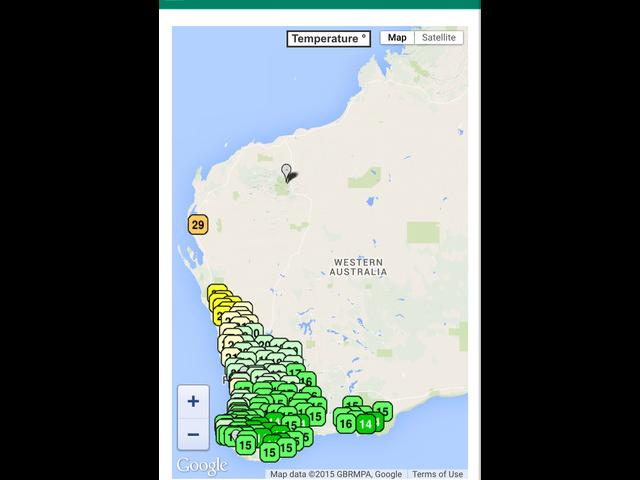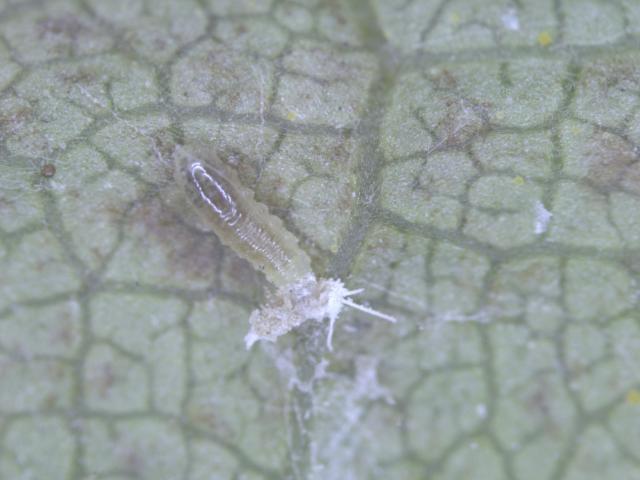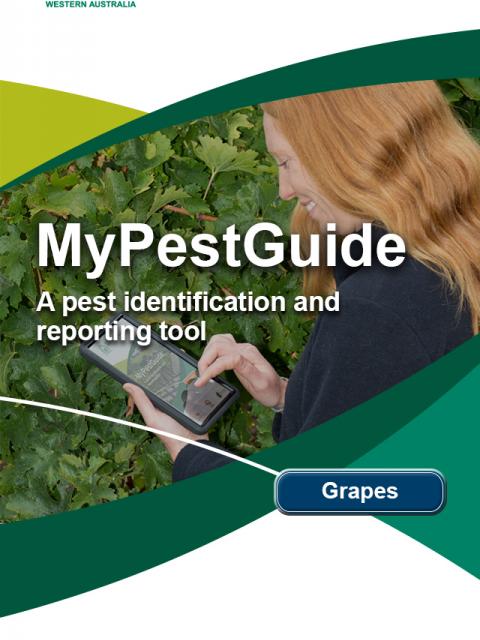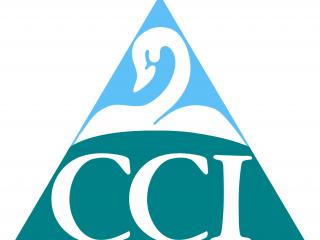New weather app to assist wine growers
Courtesy of DAFWA, wine producers now have access to live local weather data via a new smart phone app. Named ‘DAFWA weather’ the free app gives users access to over 130 weather stations across the state.
Each station provides a report every 10 minutes with base data including air temperature, humidity, rainfall, wind speed and direction, with most stations also measuring incoming solar radiation to calculate evaporation.
There are also derived variables, such as delta-T for spraying decisions, and evapotranspiration for irrigation scheduling. Wind speeds and direction are shown for the most recent minute, and an average for the past 10 minutes.
The app works on iphone and iPad, as well as Android phones and tablets.
For more details on the features of the app see the DAFWA weather stations app page.
Insect and mite monitoring
Mealybugs
Since the March article on mealybugs, further monitoring in two Margaret River vineyards has been undertaken, one planted with Chardonnay and the other with Shiraz.
The following graphs show the observations from the monitoring.
Figure 1 illustrates the effect of an insecticide spray applied to a block of Chardonnay and the subsequent breeding of mealybugs after harvest. This breeding would have been from insects under bark not affected by the spray.
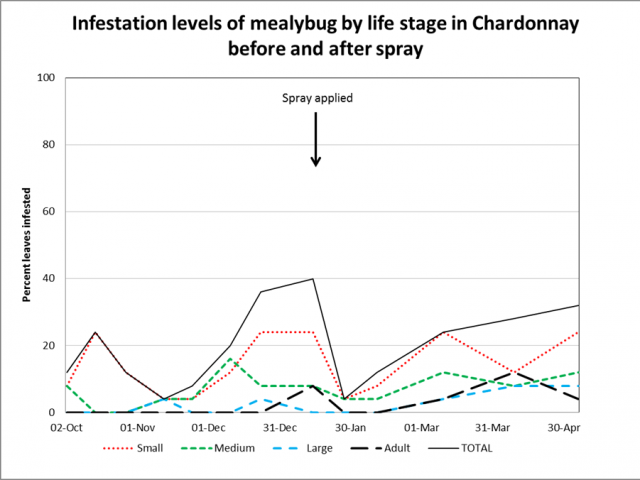
Figure 2 graphs the percentage of leaves infected with mealybug of various life stages at two separate locations within the same block of Shiraz before and after a post-harvest spray. The spray resulted in good population reduction especially of the early stages of the mealybugs.
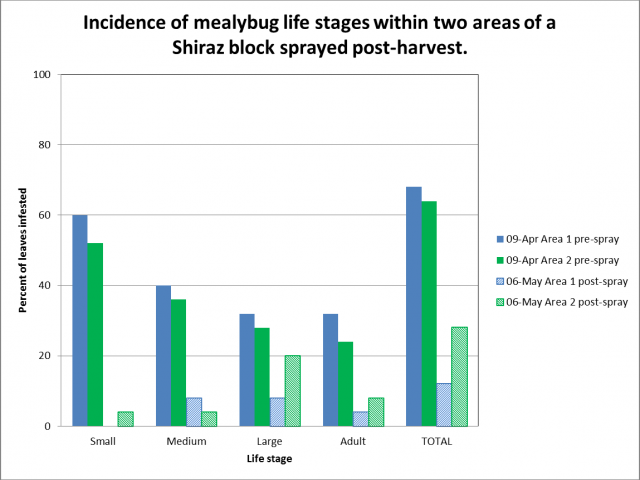
The main point from these findings is that, if mealybugs have been noticed during the growing season, monitoring post-harvest is worthwhile. If numbers continue to rise which would be expected, management options should be considered.
Controlling mealybugs that continue to feed and breed on leaves post-harvest cannot guarantee absence of the pest in the following season but it may take pressure off any control measures adopted. This is applicable for earlier maturing varieties in particular because of the greater potential for population increase between harvest and vine senescence. This was the objective in the Shiraz block where mealybug numbers were very high near harvest.
Biological control
Unlike table grapes where the withholding period for insecticides allows use up to seven days before harvest, restrictions in vineyards for export wine means no synthetic insecticides are available for use against mealybugs after 80% capfall.
This provides an incentive to consider the use of natural enemies. Two predators are available commercially - the mealybug destroyer (Cryptolaemus montrouzieri) and green lacewing (Mallada signata).
Comments from one vigneron who releases green lacewing to control mealybugs indicated that he was happy with their performance. It is difficult to empirically confirm their value but the bottom line is that in this vineyard there were no problems with premature defoliation, excessive insect numbers in bunches at harvest or sooty mould on bunches.
Whilst checking leaves in May in one of the blocks where lacewings had been released, other naturally occurring control agents such as parasites and predators were observed (see photos above and below). This is a good reflection on how this vineyard is promoting an environment suitable to natural enemies.
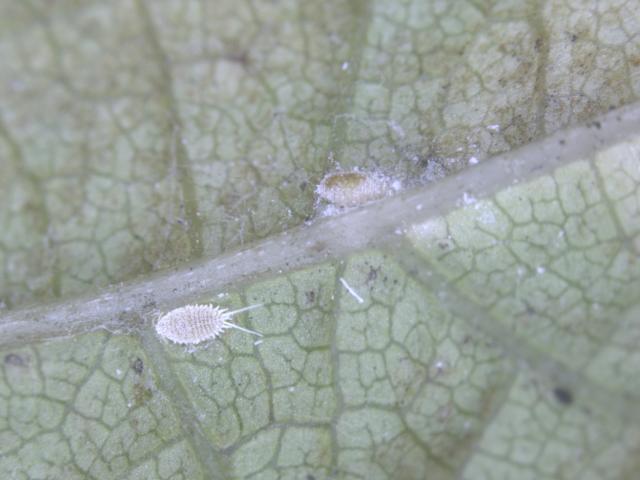
Unfortunately the only time these others predators are likely to be seen are when mealybug numbers have already built up. Therefore the release of predators needs to occur early in the season if this means of pest management is to be attempted.
A new article Mealybugs in grapevines and deciduous fruit tree crops has recently been published on the DAFWA website. This provides details on the life cycle, seasonality, pest status, monitoring and control for the two species of mealybugs that occur in WA vineyards.
Six-spotted mite
This season, a small number of vineyards in the Karridale and Pemberton areas were infested by six-spotted mite prompting limited application of miticide.
In one case, pre-emptive spraying was conducted in January while on two other vineyards post-harvest application of miticide was undertaken.
In all instances, these vineyards have a history of infestation by this mite. For such situations, there is a case for investigating the role of inundative release of predatory mites either post-harvest or in early to mid-summer, as soon as monitoring confirms the mite is present in sufficient numbers to warrant such releases.
Whether released predatory mites provide sustained longer term suppression of six-spotted mite into following seasons has yet to be investigated.
More information can be found on the six-spotted mite DAFWA webpage.
Apple looper
After unsuccessful attempts to rear sufficient numbers of apple looper larvae to the pupal stage for a New Zealand laboratory to develop prototype pheromones, we are investigating another approach to reach this objective.
Contact with a now retired Australian pheromone chemist has provided an opportunity to screen ‘off the shelf’ mixtures of likely candidate pheromone attractants.
A joint application for two sources of funding to investigate this opportunity has been successful.
Apple looper is not just an issue for vignerons. Living up to its common name, this insect is also a pest in WA’s apple orchards.
Funding for this project has been agreed to by the Grassroots Program of Australian Grape and Wine Association (AGWA) and by apple orchardists via Pome West, their fee for service program with the WA Agricultural Produce Commission.
This coming season the candidate pheromone mixes will be deployed at two sites that suffer consistent infestations with apple looper. One site will be a vineyard in the Carbanup sub-region of Margaret River and the second an apple orchard in the Perth Hills.
Measuring moth catches and subsequent presence of apple looper larvae will be used to gauge whether the pheromones can be used as a monitoring aid to avoid damage by this pest.
More information can be found on the apple looper DAFWA webpage.
Please contact Stewart Learmonth or Helen Collie on +61 (0)8 9777 0000 for more information.
New biosecurity appointment
Development Officer Alec McCarthy has been appointed to deliver outputs of the new activity ‘Surveillance and diagnosis for pests and diseases in the WA grape industry’ — or more simply referred to as the grape e-surveillance activity.
Alec, based at the Department of Agriculture and Food, Western Australia’s (DAFWA) Bunbury office has over 20 years’ experience working with a range of fruit industries in industry development and adoption of new practices.
Grape e-surveillance is part of the Boosting Biosecurity Defences project — a $20 million Royalties for Regions project launched in October 2014 which is being led by DAFWA.
The aim of this project is to support the development of strong and innovative biosecurity defences that will protect both existing and future markets.
The first task of the grape e-surveillance activity is the development of a database of pests and diseases of threat to the WA grape industries for use in a new app designed to allow simple and fast reporting and identification of potential biosecurity threats.
The app will also provide an easy and fast method for identifying and recording the occurrence of established pests and diseases within your vineyard. This can be used to monitor prevalence of problematic pests or diseases within your vineyard or regional area.
The app — ‘MyPestGuide for grapes’ — will be available for both Android and Apple mobile devices and is free of charge. A testing beta version is planned for July 2015 with a first release of a functional version in January 2016.
The MyPestGuide for grapes app is based on the operational platform of a similar app, MyPestGuide for grains, which is currently available for download and use. Growers interested in getting a preview of the concept of the MyPestGuide for grapes app may like to download the grains app.
Unlike the grains app which currently only provides for pest issues, the grape app will cover both pests and diseases.
More information on the progress of the MyPestGuide for grapes app and the future stages of the overall activity will be provided to industry at the various industry workshops held throughout the year and future editions of WIN.
For more information email Alec McCarthy or phone +61 (0)8 9780 6273.
Successful field days
Field days in Margaret River and the Swan Valley were held last month as part of the Regional Program funded by AGWA. The two events attracted 55 attendees who heard from an array of local and interstate speakers.
Dr Tony Proffitt from AHA Viticulture provided an overview of the application of unmanned aerial vehicles (UAVs) for viticulture. Although it is still early days in the application and adoption of this technology there is strong interest from growers especially in relation to precision viticulture. At the Margaret River event a number of UAVs were on hand for inspection and demonstrations were provided.
Howard Park viticulturist Tristian Moore presented findings from this season’s trial on managing extreme heat and wind events with sunscreen products and shade cloth respectively. Unfortunately the 2015 season lacked significant heat but the results did see a reduction in typical levels of exposure. While all treatments showed benefit, the shade cloth showed to be effective in limiting damage at fruit set.
Attendees had the opportunity to taste wines made from the different treatments, comments were made on the differences in the tannin structure between treatments. Overall the trial showed promising results and will be repeated for the following season.
AWRI senior viticulturist Mardi Longbottom gave a detailed presentation on nitrogen management. With data from five monitored sites across Australia, Mardi provided a good insight of the value of considering the principles of different pathways of nitrogen loss in the vineyard. It was made clear that application of chicken manure requires careful consideration before applying.
DAFWA development officer Alec McCarthy introduced the new Royalties for Regions program ‘Boosting our Biosecurity Defences in the WA agriculture and food sector’. A part of this program is the development of a new smart phone app that will allow producers to identify and monitor vineyard pests and diseases and quickly report any unusual symptoms.
At the Swan Valley event, Peter Nash of Growing Australia gave an overview of the DAFWA funded program - Plan, Prepare and Prosper for Horticulture. This five day workshop is free to eligible horticultural businesses and aims to assist farms in making their businesses more strategic and efficient.
Participants will be guided by a team of experienced facilitators, all with significant agricultural backgrounds, through a wide range of practical exercises and tools to put together a Strategic Business Plan for their horticultural enterprise.
Biological tools in organic vineyards field day
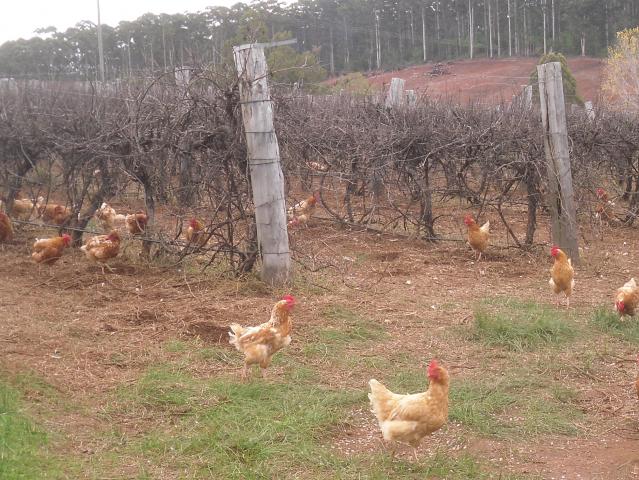
The event will hear from Dr Gary Cass, UWA scientist and developer of Fermented Fashion, clothing made from wine and beer, a bacterial process accidentally discovered while working in a vineyard.
Dr Cass will conduct a practical microscope session on identifying soil biology. This will be followed by a vineyard walk with a discussion about the benefits of soil biology and how it can be promoted.
The event is part of a project being coordinated by Warren Catchments Council with support from South West Catchments Council and funding from the Australian Government’s National Landcare Program.
The project is using biological management practices with the aims of suppressing pests and fungal diseases and improving the soil condition throughout the 7ha of vineyard and orchard.
Baby doll sheep are to control grasses and weeds with free range poultry following the sheep in predator-deterrent electric fenced cells, feeding on pests and scattering sheep manure.
Stock are offered mineral supplements, including organic apple cider vinegar, which is reputed to benefit animal health, nutrient cycling and soil biology. Soil chemical imbalances will also be addressed.
It is predicted that minor surface disturbance and improved nutrient cycling will increase soil biological activity, soil structure and soil health, and that this will result in elevated sugar levels in both grapes and apples.
Further details of this trial can be found at agtrialsites.com.
To RSVP (deadline 1 July) or to receive more information about the field day please email Kathy Dawson at Warren Catchments Council or contact on +61 (0)8 9771 8180.
Obligations of wine industry employers
Pruning season is a time of peak seasonal labour requirement for the wine industry, and is also a time when many producers utilise contractors, labour hire firms and a workforce from overseas.
In the last 12 months there has been significant media interest in the employment practices of the agrifood sector, and the WA Wine industry were the target of talkback radio calls only last month.
Whilst there is no suggestion that the WA wine industry in doing anything wrong, there is a clear need for industry to, not only understand employer obligations, but to be able to show compliance with National Employment Standards.
Why is compliance important? Because failing to comply with the relevant Industrial Relations system and the Fair Work act can result in:
- Underpayment claims from employees, including backpacker workers, and contractor staff if they have not received the minimum pay entitlements.
- Pecuniary penalties of up to $51,000 for body corporates and $10,200 for individuals.
- The reputational damage that comes from these types of claims.
The Fair Work Ombudsman (FWO) has been actively running a “Harvest Trail” campaign since 2013 auditing and educating horticultural and viticultural businesses about their obligations around the country. So far they have received complaints from workers on being short-changed on transport and accommodation costs, substandard accommodation and rates of pay.
Wine businesses can also be subjected to accessorial liability, meaning you may be liable for actions you are not involved in, but are aware of, such as underpayment of contractors or Labour Hire workers.
The good news for pruning season is that piece workers are allowed under the wine industry award. The bad news is that piece work rates is the most common issue highlighted by the FWO in the harvest campaign. Employers have a clear obligation to ensure that an average competent employee working at an average speed can earn at least 20% more than the casual hourly rate under the award.
Again there is no suggestion that the Wine industry is currently doing anything wrong but it is critical that the piece work arrangement is set out in writing. No signed paperwork means a worker is not considered a pieceworker and is entitled to the minimum hourly/weekly rate as prescribed by the award.
This could be very costly for the employer. In view of recent media interest, we expect more complaints to the FWO, particularly from Working Holiday makers. There are also further obligations on employers to ensure that workers with limited English understand the arrangement. If you are using a labour hire company you should also have a clear understanding of the employment arrangements of their staff so you cannot be subjected to accessorial liability claims.
If you need further advice, the Chamber of Commerce and Industry (CCI) have the largest team of employee relations specialists in WA and can provide advice on developing HR policies that meet current legislative requirements and assist employers resolve employee disputes in-house.
For further information and assistance contact Jackie Jarvis, CCI Consultant – Agrifood Labour & Skills on +61 (0)428 645 812.
Future events
Biodynamic tools for organic vineyards field day
When: 3 July 2015
Where: Mountford Wines, Bamess Rd, Pemberton
Cost: TBA
See the event flyer for more details.
WineTech 2015
The national wine industry supplier trade show.
When: 14 -16 July 2015
Where: Adelaide Showground, SA
Please see the events website for further details.
Cowaramup Agencies Viticultural Trade Day
When: 22 July 2015
Where: Cowaramup District Club
For more details please contact Cowaramup Agencies on +61 (0)8 9755 5279
ASVO Seminar
Vineyard longevity – maintaining the asset
When: 22 – 23 July 2015
Where: Mildura Arts Centre, Mildura, Vic
Please see the events website for further details.
Spring Updates
Two workshops are being scheduled for September to present the latest in research and development projects being conducted in WA from both DAFWA and Curtin University. Topics will be of interest to both winemakers and grape growers.
When: 22 and 24 September 2015
Where: Margaret River and Great Southern
Cost: Free
Confirmation of dates and further information on the program and registration will be made available closer to the events.

